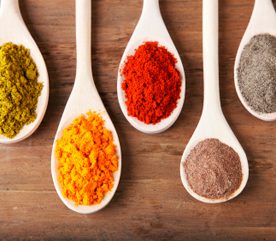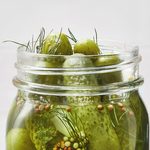Guide to Herbs and Spices
Give your recipes a kick by experimenting with herbs and spices. This A to Z guide will demistify the spice rack so you can start experimenting now.

Allspice is just what its name implies: a single spice that tastes like a mixture of cinnamon, nutmeg, ginger, and pepper, which adds spiciness to all dishes.
Anise has a strong licorice flavour, making its seed popular in cakes and cookies. Ground anise seed is used with fruit or cabbage. Star anise is a similar spice from Asia.
Basil has a distinctive warm, minty flavour, and is most frequently used for pesto sauces and tomato dishes. It goes well with most Mediterranean-style dishes.
Bay leaf has a pungent woodsy flavour, and aroma that complements meats, soups, and stews. Add the dry, brittle leaf at the beginning of cooking to allow time for it to release its flavour. Remove leaf before serving.
Black peppercorns are sharp and aromatic. Freshly ground black pepper from a pepper mill gives the most flavour.
Caraway seeds, small and aromatic, have an anise-like flavour. They add that flavour and a nutty texture to breads, cakes, cheeses, vegetables, and meats.
Cardamom comes from the ground seed of an Indian plant in the ginger family. It is a spice used mainly in curries and baking.
Cayenne, ground dried red chili peppers and their seeds, is hot and peppery in sauces and stews.
Celery seeds, tiny as they are, can give a strong celery flavour to sauces, dips, stews, or soups.
Chervil is an anise-tasting herb that enhances egg, chicken, shrimp, and salad dishes.
Chili powder, which comes in hot or mild versions, is a mixture of ground dried chilies, and other herbs, such as garlic, oregano, cumin, coriander, and cloves.
Chives add a sweet onion flavour to salads, sauces, and dips. They are an easy perennial to grow, but also can be bought fresh, frozen, or freeze-dried at grocery stores.
Cilantro, and coriander, refer to the same plant. Its fresh green leaves are very aromatic and distinct in their flavour, and are popular in Mexican and Southwest American dishes as well as Asian cooking. The ground seeds are used in curries and spice cakes.
Cinnamon comes in stick form (good for spicing up hot ciders) or ground (mix with sugar for cinnamon toast). Cinnamon flavours sweet rolls, spice cakes, and puddings. It is also used in Moroccan and Greek entrees and pilafs.
Cloves are used to stud hams before baking or spike apples for a cider punch. Use ground cloves for spice cakes or puddings.
Cumin seeds and ground cumin have an earthy flavour that adds richness to Mexican, bean, and shellfish recipes.
Dill, either freshly chopped or dried dill weed, gives a fresh flavour to beets, carrots, cucumbers, pickled vegetables, potatoes, and seafood. Dill seed is used in pickling.
Fennel seeds have an anise flavour that goes well with fish and pork.
Gingerroot has a sharp, lemony flavour. Fresh gingerroot is peeled and grated or diced and added to stir-fries or spicy stews. Store fresh ginger, well wrapped, in the freezer. Ground dried ginger is used in cakes and cookies as well as some curries.
Mace is the external covering, or aril, of the nutmeg seed that is also and ground for use as a spice. It is hotter and less subtle than nutmeg and a classic spice for pound cake.
Marjoram has a spicy, fresh flavour that goes with most vegetables, especially those used in Mexican, Greek, and Italian recipes.
Mint has a light, fresh taste that enlivens fruit drinks like lemonade and fruit salads; it also enhances the taste of lamb and fish.
Mustard seed is used to make many popular commercial spreads from Dijon to hot dog mustard. Ground mustard seed, hot and pungent, is also an important ingredient in homemade mayonnaise, and many sauces and gravies served with fish, poultry, and meat.
Nutmeg has a warm, sweet, nutty flavour that complements spinach, pumpkin, and cheese dishes as well as puddings.
Oregano, like a stronger version of marjoram, enhances tomato, cabbage, poultry, beef, veal, and lamb recipes.
Paprika, like cayenne, is ground dried red peppers but in a combination that is milder and sweeter. Hungarian paprika is among the best, aromatic and delicious. Some paprika sold in Canada is so mild that it is used as decoration only.
Parsley comes in two versions, curly-leaf and flat-leaf. The two kinds can be used interchangeably to add a fresh taste to potatoes, grains, mushrooms, and meat. Chewing fresh parsley is said to freshen the breath.
Red pepper flakes are made from crushed, dried chili peppers and are very hot. Use them to add hotness to chilies and stews.
Rosemary has an intense, earthy flavour that makes it especially good for marinades and grilled foods, such as lamb. Used sparingly (because it is strong), it complements beans, legumes, mushrooms, peas, summer squash, and zucchini.
Saffron, the most expensive of all spices, is obtained from the stamens of a single variety of fall crocus. It is used to flavour-and color-rice, vegetable soups, fish dishes, and sweet rolls.
Sage has a woodsy, aromatic flavour that is often used in Italian cooking, blending well with garlic and tomatoes. It also goes well with onions, legumes, pork, poultry, and stuffing.
Sea salt, such as fleur de sel from France and alaea from Hawaii, is literally taken from the sea; it’s what’s left when the water is evaporated. Depending on its source, sea salt has subtle flavours from trace minerals. It is coarse and should be sprinkled on food after cooking.
Summer savory is a slightly peppery herb that spices up green beans, dried beans, cabbage, Brussels sprouts, and potatoes as well as fish, poultry, and pork.
Tarragon, a popular French herb, has an anise-like flavour that complements carrots, greens, chicken, seafood, and egg dishes.
Thyme has a light, spicy flavour that marries well with carrots, mushrooms, and salad greens, as well as beef, pork, lamb, poultry, and oil-rich fish. It is especially tasty in soups, and stews.



